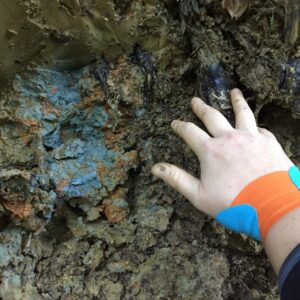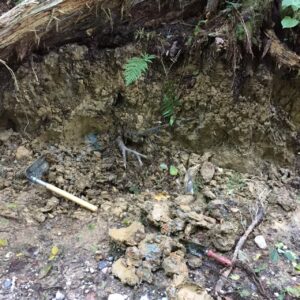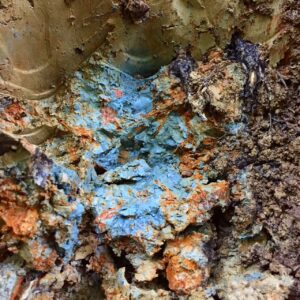Clay that was blue
Usually clay in Slovenia is in layer of different colours. Mostly I can only get to higher layers, because sometimes grey-er clay are at few meters of depth. Sometimes clays are dark grey even at the surface, but usually its red, orange and yellow-ochre. Sometimes between red clay you find small pockets of clean grey clay. It is impossible to separate it from lines of red irony clay. But the contrast can be so pure, that in grey you see blue.
But not this time. Živa took me to a slope leading towards Sava river, just behind her house. She says she normally doesn’t like to go there by her self, because she heard some horror stories associated with that forest. Stories like people go there to make suicide. There was this one case of the body being dropped from the trees. It was hanging there for a while, so high, that no one could see it until id degraded ad fell down. There are also giant conglomerate boulders. She says they are scary too.
The slope is beautiful. A forest road is cut between trees and is directed downwards toward the river. When you start on the top of plateau ground is very rich in iron. You get burgundy reds, aubergine purples, rusty orange, all kind of orange, and warm yellows. All that as a mix of clay, sand and sandstones. Once you start descending, colour are slowly changing to browns, and after a little grey. We stopped there, to collect some clay, which happens to be very – we say greasy – which is good, just where tractor damaged the slope to clear the path and opened a nice line of clean clay. We started collecting, but I always want to see the whole menu. So I went a little further, and under a tree, between the tree’s roots, I see a very peculiar clay. It was really blue. We started digging into it and around it, but there was only a very small pocket. It was so blue. Blue was glowing out between rusty irony lines again, but this time, it was not an optical illusion because of all the reds; it was truly blue. We collected as much as we could, and went back home. Some is still left there.
I posted a photo of the clay on Instagram, and many people screamed ‘vivianite!’ So I quickly checked internet for it because that is the first time I hear of it. So, in short, vivianite is a mineral of iron phosphate hydrate. It is named after John Henry Vivian in England. It is also called blue earth or blue ochre. It is a rare mineral. In the past it was used as blue pigment in paintings. It is formed in damp environments, in absence of sulphur and presence of phosphate. Also there where organic material is decaying. I read an article about how it is found on dead bodies sometimes. I hope there is no connection to that, thou we talked about dead bodies in that forest jut a little earlier, didn’t we?
Anyway, w have not concluded if the blue clay is vivianite or not. What did happen the next day is, that the blueness faded drastically. Because clay was exposed to oxygen. That caused a transformation of iron phosphate, maybe? So the blue clay we found maybe was a predecessor of blue ochre – which is stable and keeps it’s blue. I don’t know. I will need to talk to my geologist and discuss further.
I was a little sad that the blue faded. I kept the sample, I will fire it and maybe learn something from that too. You think it s something to do with vivianite or it is just blue clay?



